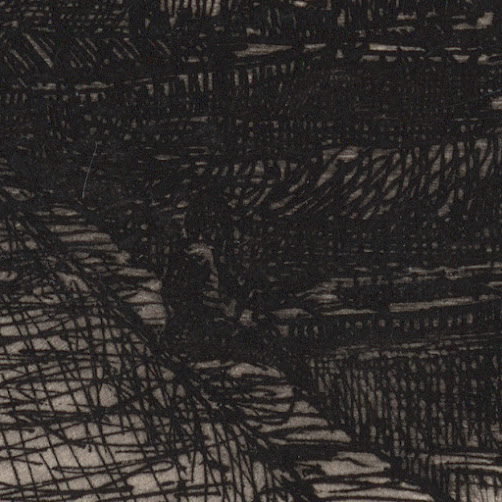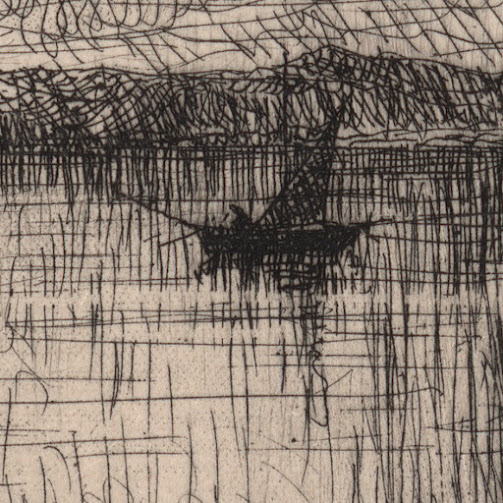Albrecht
Altdorfer (1482/5–1538)
“St Christopher Bearing the Christ Child”
(aka. “S. Christophe portant l’enfant Jésus”), 1513, a later impression—note
that Baron Hans Albrecht von Derschau printed an edition of this print between
1808 and 1816 on a greyish paper and further impressions were taken from the
original block, now in the Kupferstichkabinett (Berlin), between 1922 and 1963.
Woodcut on wove
(Japanese?) paper trimmed with a narrow margin around the image borderline.
Size: (sheet) 17.4
x 12.7 cm; (image borderline) 16.5 x 12.1 cm.
Dated and
signed in the block with the artist’s monogram: (on tree at right) “1513/
[monogram with ligature initials] AA”.
TIB
14(6).53(79) (Robert A Koch 1980, “The Illustrated Bartsch: Early German
Masters; Albercht Altdorfer; Monogrammists”, vol. 14, New York, Abaris Books,
p. 159, cat. no. 53 [79]); New Hollstein w.56 (Ursula Mielke [comp.] 1997, “The
New Hollstein German Engravings, Etchings and Woodcuts 1400-1700: Albrecht and
Erhard Altdorfer”, Rotterdam, Sound and Vision Interactive, p. 130, cat. no.
w.56).
The Rijksmuseum
offers the following description of this print: (transl.) “Saint Christopher
wading through the river with the Christ Child on his back. He bends under the
weight of the child and holds on to his staff” (http://hdl.handle.net/10934/RM0001.COLLECT.30781).
The Curator of
the British Museum offers the following insights about this print (note that
the numbers in brackets reference the BM’s inv. nos.): “Altdorfer has reduced
the amount of hatching normally seen in his woodcuts to a minimum, restricting
it to the areas of deepest shade, so that the outlines of the woodcut are
firmly emphasised. Like Baldung's 'St Christopher' of c.1511 (1895,0122.227),
it is conceivable that it was designed with a tone block in mind, so that parts
of the sheet were left intentionally blank to receive the coloured areas. But
no such colour print is known, and the small size of this woodcut would seem to
argue against this idea; colour prints of the period, such as Altdorfer's
'Beautiful Virgin' of Regensburg (1909,0612.3), were usually of larger
dimensions. It is possible that Altdorfer was attempting to reproduce the
outline effect of a pen drawing or an etching in the medium of woodcut with not
altogether successful results, in much the same way as he aspired to mimic the
effects of small, finely detailed engravings in his accomplished woodcut series
of the 'Fall and Redemption of Man' (1837,0616.225-226; 1845,0809.1191-1192;
1837,0616.229; 1845,0809.1194; 1837,0616.231 and 1845,0809.1196)” (https://www.britishmuseum.org/collection/object/P_1895-0122-363
[BM inv. no. 1895,0122.363]).
Condition: a
very strong impression trimmed with a narrow margin around the image borderline
in a near pristine condition.
I am selling
this magnificent late impression of a Renaissance period woodcut by one of the
founders of landscape painting, Albrecht Altdorfer, for AU$368 in total
(currently US$254.09/EUR227.51/GBP189.99 at the time of posting this listing) including
Express Mail (EMS) postage and handling to anywhere in the world, but not (of
course) any import duties/taxes imposed by some countries. Note that payment is
in Australian dollars (AU$368) as this is my currency.
If you are
interested in purchasing this amazing woodcut—note Altdorfer’s inventive use of
bold diagonals and the subtlety of his portrayal of the infant Christ advising
St Christopher as the saint struggled to wade across a river with increasing
weight on his shoulders that he was carrying not only the king of world but
also the weight of the world—please contact me (oz_jim@printsandprinciples.com)
and I will send you a PayPal invoice to make the payment easy.
Note that this
is the second copy of this woodcut that has been listed. The previous impression
has been sold.
This print has been sold


















































